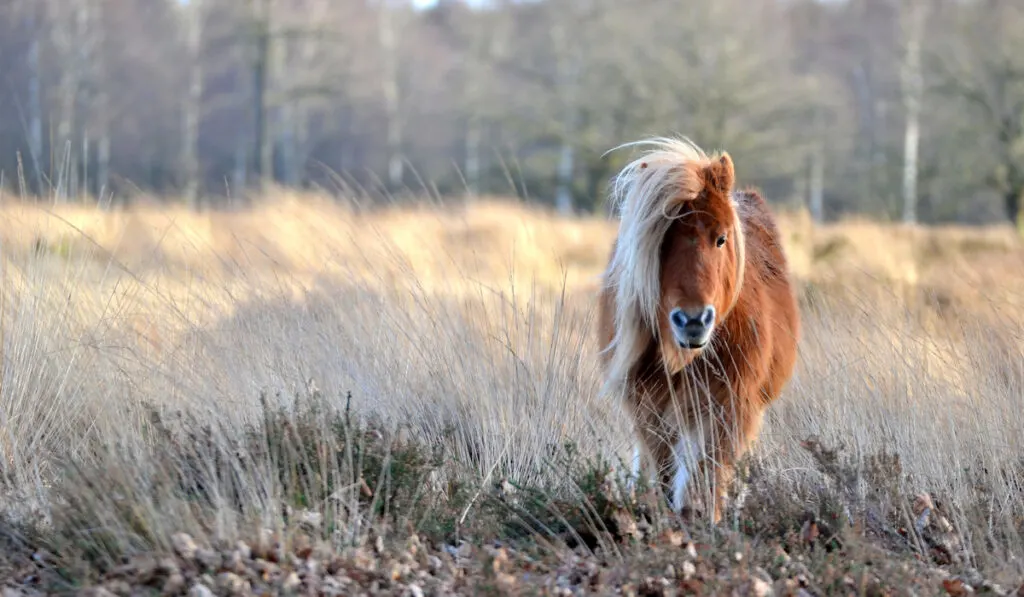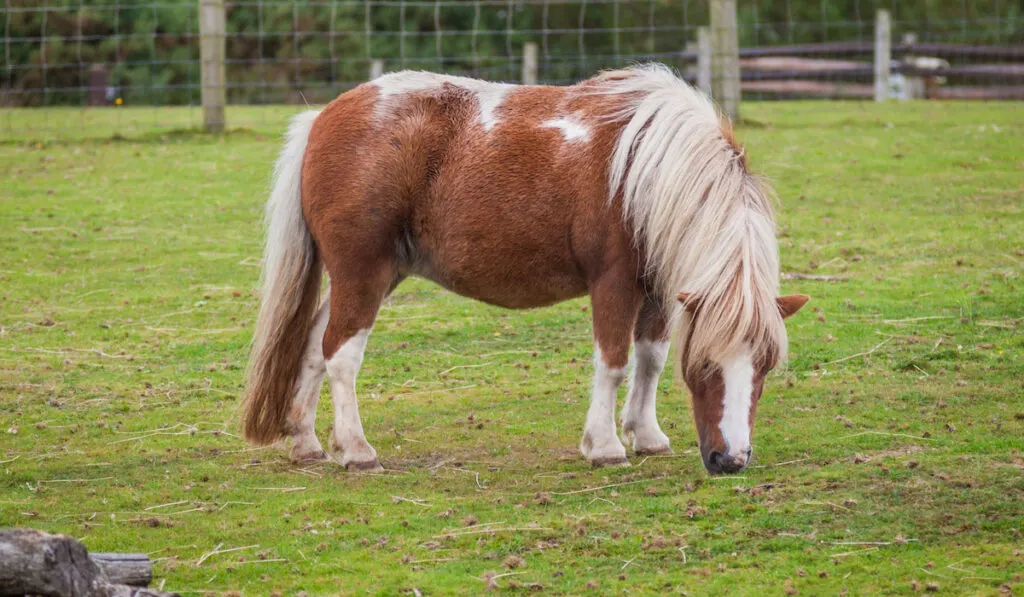Shetland ponies are one of the most popular pony breeds in the world. They make for wonderful pets, companions, and riding ponies. Their small size, incredible strength, and generous coat and mane have fascinated horse lovers for centuries. Today, they continue to be a favorite for children and adults all around the world.

Table of Contents
1. Shetland Ponies Originated in Scotland
Shetland ponies originate from the Shetland Isles in the north of Scotland. The Shetlands are located in the North Atlantic, 170 km from the Scottish mainland.
As such, the Isles are known for their rugged terrain, scarce vegetation, and cold and windy climate.
However, it is precisely these harsh conditions that helped the Shetland pony develop their unique characteristics, from their small size and strength to their thick coat and resiliency.
2. They Have Been Around Since the Bronze Age
Scientists believed Shetland ponies roamed the hills of the Shetland Isles as far back as 8,000 years ago or at least since the Bronze Age (3,000 BC). (source).
Around 2,000 BC, settlers brought the Celtic pony to the area, which probably influenced the development of the Shetland pony breed we know today. (source).
3. They Were Once Used as Mining Horses
Shetland ponies were used in domestic settings by the farmers on the Isles for hundreds of years.
Starting in the 1840s, Great Britain introduced new laws banning women, girls, and boys from working in coal mines. The Shetland pony took over this lost labor–the small size of the breed allowed them to easily enter the underground tunnels carrying heavy loads of coal. (source).
The demand for Shetland ponies, as well as their popularity, started to increase during this time.
4. Breeding of Shetland Ponies Started in the Late 1800s

As the popularity of Shetland ponies grew, so did the demand. While initially Shetland ponies were rounded up in the Isles and exported to the mines, starting around 1880, they started to be bred on the Island.
In 1890, the Shetland Pony Stud-Book Society was formed to regulate and keep track of the breeding of Shetland ponies. (source).
In 1885, the first Shetlands were exported to the United States. The American Shetland Pony Club was established in 1888 to document and record the Shetland breed in the country as well to develop a new American Shetland breed.
5. Shetlands Are One of the Smallest Horse Breeds in the World
The average height of Shetland ponies is about 40 inches or 102 centimeters. American Shetlands can stand up to 46 inches (117 centimeters).
However, the breed standard set by the UK Shetland Pony Stud-Book Society is a maximum of 42 inches (107 cm). Except for some dwarf ponies, this makes Shetland ponies one of the smallest horse breeds in the world. (source), (source).
6. They Are Very Strong
Shetland ponies reach a weight of 400 to 450 pounds as adults. They have very compact bodies, with a thick neck and short legs.
While they may look cute, Shetlands are one of the strongest pony breeds in the world. For example, Shetland ponies can pull up to twice their weight; a draft horse, only half of his! (source). In our article on pony carrying capacity, we delve more into this unique feature of Shetland ponies.
7. They Are Known for Their Thick Coat and Lush Mane
One of the most distinct characteristics of Shetland ponies is their thick coat and abundant mane and tail.
During winter, Shetland ponies have a double coat that protects them from the cold and keeps them dry in the rain. In the summer, Shetlands shed this coat to reveal a shiny and silky short coat underneath. (source).
8. Black Is the Most Popular Shetland Pony Color
However, their coat can be any color, except spotted. The most common coats are chestnut, bay, black, and pinto.(source).
Shetland ponies’ coat can also be “piebald,” which means black and white, and “skewbald,” which means a combination of white and any other color. (source).
9. They Are Very Good Swimmers
Shetland ponies love the water. They are natural swimmers, so there is no need to teach them how to safely navigate a body of water.
Being good in the water is a great advantage, as, on very hot days, Shetlands can easily cool off by taking a swim. (source).
10. Shetland Ponies Have a Simple Diet
The long and cold winters of the Shetland Isles meant that Shetland ponies evolved in an area where food was scarce. Shetland ponies’ metabolism adapted accordingly, and even today, these hardy ponies can survive on little food.
The best diet for Shetland ponies is quality grass hay. A rich diet, e.g., alfalfa or clover, is not recommended as it may lead to obesity. (source).
11. They Have a Long Gestation Period
The gestation period for Shetland ponies is 11 months. Shetland ponies are left with their mothers until they are 5 or 6 months old, after which they are weaned.
Like any other pony or horse, the baby, called a foal, will be able to stand after about one hour and start walking shortly after. (source).
12. Shetland Ponies Usually Outlive Horses
Shetland ponies can live to about 30 years old. Research shows that ponies are more efficient in regulating their respiratory system during exercise, have a thicker and denser bone structure, and simply do not go as fast as horses, all reasons why they have longer lives. (source).
One of the most famous older equines ever was Sugar Puff, a Shetland pony who lived until 56 years old before he died in 2007. (source).
13. Shetland Ponies Are Great With Children
In addition to their small size, Shetland ponies’ gentle disposition and well-tempered personality make them ideal as a pet for small children.
However, Shetland ponies can also be a bit stubborn and independent, so they still need to receive consistent training and supervision from an adult. (source).
14. They Are Appropriate for Riders of All Experience Levels
The Shetland Pony Club in Surrey, England believes that children can ride as soon as they have developed the core strength needed to sit upright on a horse, usually around 2 ½ years old.
Children of all experience levels can continue riding Shetland ponies until 12 years of age. Ideally, the maximum height and weight for riding a Shetland pony are 5’1” and 105 pounds.
15. Shetland Ponies Are Affordable
You can buy a Shetland pony from breeders all across the United States. The price of a Shetland pony usually ranges between $500 and $1500. (source).
There are also many organizations offering Shetland ponies for adoption. A good place to start is your local animal rescue group.
16. They Need Company
Shetland ponies are happier when living with their Shetland brothers and sisters. This is because Shetland ponies evolved living in a herd for protection.
If adopting or buying a Shetland pony, you should consider if you can adopt them in pairs. If this is not possible, make sure they have other animals that will offer companionship to your pony. Another horse, or even a cow, will be a good friend to a Shetland pony. (source).
17. They Need Space to Move Around
Shetland ponies may be small, but they do need some space to move around. You should provide a minimum of one acre (4,000 square meters) of land for your pony to graze and exercise.
Although strong and able to live outside for most of the year, Shetland ponies also need a stable where to take shelter from the sun in the summer or the rain during the winter months. (source).
Resources:
When learning about ponies it’s important to consult a variety of sources. These are the sources used in this article.
- https://www.thesprucepets.com/meet-the-shetland-pony-1885871
- https://www.shetland.org/things/explore-nature/shetland-ponies
- http://www.shetlandponystudbooksociety.co.uk/about-the-breed
- https://www.shetlandminiature.com/about-us-photo/our-history
- https://www.britannica.com/animal/Shetland-pony
- http://www.shetlandponystudbooksociety.co.uk/about-the-breed/breed-standard
- https://animal-world.com/horses/Pony-Breeds/ShetlandPony.php
- https://books.google.it/books?id=Eus9DwAAQBAJ&pg=PA176#v=onepage&q=shetland&f=false
- https://equusmagazine.com/behavior/shetlandprofile041298
- https://www.youtube.com/watch?v=O_rHrMBZiHg
- https://www.thebarkspace.com/best-feed-for-shetland-pony/
- https://equusmagazine.com/horse-care/mare_foal_behavior_121508-8331
- https://www.horseandhound.co.uk/features/ponies-are-they-really-healthier-than-horses-397832
- https://www.thesprucepets.com/how-old-is-the-oldest-horse-1887321
- https://www.thesprucepets.com/great-horse-and-pony-breeds-for-kids-1886142
- https://shetlandponyclub.co.uk/what-age-can-you-ride-a-shetland-pony-tv229/
- https://www.thesprucepets.com/meet-the-shetland-pony-1885871#grooming
- https://www.youtube.com/watch?v=brrA-vUGEyk
- https://shetlandponyclub.co.uk/can-i-keep-a-shetland-pony-in-my-garden-tv232/
- https://www.youtube.com/watch?v=nAzVME4FWAs

